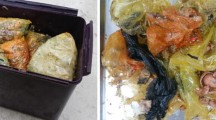Abstract
Anaerobic digestion has become a promising technology in waste management by converting an organic waste into biogas. From the present study, the optimum food to microorganism ratio (F/M) in anaerobic biodegradation has been evaluated. Also, using the optimum F/M ratio, the batch test study was conducted in different phases and under different temperature conditions for anaerobic digestion of food waste. The data obtained from the study has been used to calculate the methane generation rate constant (k) and measurement of biochemical methane potential (BMP) in anaerobic biodegradation. During anaerobic digestion, food waste (with total solids content of 15–30 %) was loaded with the inoculum (seed sludge with total solids content of 10 %) in the serum bottles (working volume 400 mL) and was incubated under mesophilic temperature conditions of 30 ± 2 °C, thermophilic temperature condition of 50 ± 2 °C, and under psychrophilic condition of 15 ± 2 °C for 40, 30, and 60 days respectively, at F/M ratio of 0.75. Also, maximum methane production of 0.88, 0.62, and 0.73 L CH4/g chemical oxygen demand (COD) was found under mesophilic, thermophilic, and psychrophilic conditions, respectively. At this maximum biogas production, the rate constant (k) was measured as 0.18, 0.23, and 0.10 days−1, respectively. Also, the BMP was measured as 84, 74, and 70 % at mesophilic, thermophilic, and psychrophilic conditions for 40, 30, and 60 days, respectively. In this study, the maximum biogas production was obtained at mesophilic conditions at food to microorganism ratio 0.75.








Similar content being viewed by others
References
Prema Viswanath S, Sumithra D, Krishna N (1992) Anaerobic digestion of fruit and vegetable processing wastes for biogas production. Bioresour Technol 40:43–48
Saxena M, Asokan P (2002) Timber substitute products from industrial solid wastes. In: Rajisnish S (ed) Proceedings of the 18th national convention of environmental engineers and national seminar on solid waste management, vol 18. Bhopal, India, pp 192–200
Emerson news (2013) India Wastes INR 133 Billion of Fruits and Vegetables Annually Due to Inadequate Cold Chain., Emerson Report Highlights. http://www.emerson.com/en-IN/newsroom/news-releases/Pages/India-Food-Waste-and-Cold-Infrastructure-Report.aspx
Rao MS, Singh SP (2004) Bioenergy conversion studies of the organic fraction of MSW: kinetic studies and gas yield-organic loading relationships for process optimisation. Bioresour Technol 95:173–185
Pandyaswargo AH, Onoda H, Nagata K (2012) Energy recovery potential and lifecycle impact assessment of municipal solid waste management technologies in Asian countries using ELP model. Int J Energy Environ Eng 3:10–28
Xuereb P (1997) A fuel produced from waste, news. Newsletter of Michigan Institute of Waste Management 2:6–18
Ofoefule, Akuzuo U, Nwanko, Joseph I, Ibeto, Cynthia N (2010) Biogas production from paper waste and its blend with cow dung. Pelagia Research Library 1:1–8
Yang K, Tsukahara K, Yagishita T, Sawayama S (2004) Performance of a fixed-bed reactor packed with carbon felt during anaerobic digestion of cellulose. Bioresource Technol 94:197–201
Cho JK, Park SC (1995) Biochemical methane potential and solid state anaerobic digestion of Korean food wastes. Bioresour Technol 52(1995):245–253
Owen WF, Stuckey DC, Healy JB, Young LY, McCarty PL (1979) Bioassay for monitoring biochemical methane potential and anaerobic toxicity. Water Res 13:485–492
APHA, AWWA, WEF (2005) Standard methods for the examination of water and wastewater. Washington, DC 21:2131
Prashant S, Kumar P, Mehrotra I (2006) Anaerobic degradability: effect of particulate COD. Jour Envir Engg ASCE 132(4):488–496
Hussain A, Parveen T, Kumar P, Mehrotra I (2009) Phenolic wastewater: effect of F/M on anaerobic degradation. Desalin Water Treat 2(1–3):260–265
Grady CPL (1985) Biodegradation: its measurement and microbiological basis. Biotecnol Bioeng 27:660–674
Author information
Authors and Affiliations
Corresponding author
Rights and permissions
About this article
Cite this article
Kumar, P., Hussain, A. & Dubey, S.K. Methane formation from food waste by anaerobic digestion. Biomass Conv. Bioref. 6, 271–280 (2016). https://doi.org/10.1007/s13399-015-0186-2
Received:
Accepted:
Published:
Issue Date:
DOI: https://doi.org/10.1007/s13399-015-0186-2




